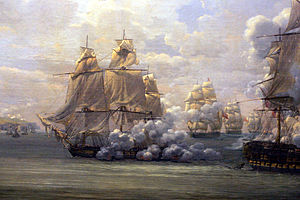Action of 28 June 1803
| Action of 28 June 1803 | |||||||
|---|---|---|---|---|---|---|---|
| Part of the Blockade of Saint-Domingue | |||||||
 Detail from the Fight of the Poursuivante against the British ship Hercules, 28 June 1803: Poursuivante delivers her decisive raking broadside. Louis-Philippe Crépin, 1819, Musée national de la Marine |
|||||||
|
|||||||
| Belligerents | |||||||
|
|
|
||||||
| Commanders and leaders | |||||||
| Captain Jean-Baptiste Willaumez Commander Jean-Pierre Bargeau |
Captain Henry William Bayntun Captain Charles Brisbane Acting captain John B. Hills |
||||||
| Strength | |||||||
|
1 frigate |
3 74-gun ships of the line | ||||||
| Casualties and losses | |||||||
| 1 corvette captured 10 men killed & 15 wounded |
A few wounded | ||||||
1 frigate
The Action of 28 June 1803 marked the opening shots of the Blockade of Saint-Domingue after the collapse of the Treaty of Amiens and the outbreak of the War of the Third Coalition in May 1803.
A French heavy frigate and a corvette, both partially armed en flûte and unaware of the recently begun war, met three British 74-gun ships of the line. The corvette was overhauled and captured, but the frigate, sailing close to shore, managed to out-manoeuver her opponent and deliver a devastating raking broadside that put her out of action.
The feat of a frigate besting a ship of the line yielded high praise for Willaumez, who had commanded the frigate. A large painting by Louis-Philippe Crépin was commissioned in 1819 to commemorate the event.
France had been in peace with Great Britain since the Treaty of Amiens in 1801, allowing her to consolidate her grasp on her colonies oversea. This was particularly sensitive in Saint-Domingue, where the Haitian Revolution had raged since 1791. First Consul Bonaparte ordered the Saint-Domingue expedition, under General Leclerc, to curtail the separatist tendencies of General Toussaint Louverture.
Meanwhile, the Treaty of Amiens proved to be an unsuitable settlement of Franco-British differences; its application by both parties became erratic and tensions grew. In May 1803, Britain declared war on France, setting the War of the Third Coalition into motion.
In late June, these news had yet to reach the French station of Saint-Domingue. On 27 June 1803, the 40-gun frigate Poursuivante, under Willaumez, departed Les Cayes, bound for Cap-Haïtien, in the company of the 16-gun corvette Mignonne, under Commander Jean-Pierre Bargeau. Neither of the ships was fully armed or manned:Poursuivante, pierced to mount twenty-four 24-pounder long guns on her battery and sixteen 8-pounders on her castles, carried only 22 and 12 respectively and, more critically, had only 25 shots for each gun and a crew of only 150 men;Mignonne, nominally carrying sixteen 18-pounder long guns, was equipped only with twelve 12-pounders and an 80-man complement.
...
Wikipedia
